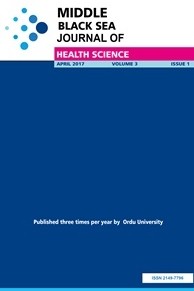Assessment of the Relationship between Vitamin D Deficiency and the Development of Hyperemesis Gravidarum
Hyperemesis gravidarum, nausea, pregnancy, vitamin D, vomiting
Assessment of the Relationship between Vitamin D Deficiency and the Development of Hyperemesis Gravidarum
Hyperemesis gravidarum, nausea, pregnancy, vitamin D, vomiting,
___
- Verberg MF, Gillott DJ, Al-Fardan N, Grudzinskas JG. Hyperemesis gravidarum, a literature review [published correction appears in Hum Reprod Update. 2007 Mar-Apr;13(2):207]. Hum Reprod Update. 2005;11(5):527-539.
- Goodwin TM. Hyperemesis gravidarum. Clin Obstet Gynecol. 1998;41(3):597-605.
- Golberg D, Szilagyi A, Graves L. Hyperemesis gravidarum and Helicobacter pylori infection: a systematic review. Obstet Gynecol. 2007;110(3):695-703.
- Einarson TR, Piwko C, Koren G. Quantifying the global rates of nausea and vomiting of pregnancy: a meta analysis. J Popul Ther Clin Pharmacol. 2013;20(2):e171-e183.
- Fejzo, MS, Ingles SA, Wilson M, et al. High prevalence of severe nausea and vomiting of pregnancy and hyperemesis gravidarum among relatives of affected individuals. Eur J Obstet Gynecol Reprod Biol. 2008;141(1):13-17.
- Gazmararian JA, Petersen R, Jamieson DJ, et al. Hospitalizations during pregnancy among managed care enrollees. Obstet Gynecol. 2002;100:94-100.
- Austin K, Wilson K, Saha S. Hyperemesis Gravidarum. Nutr Clin Pract. 2019;34(2):226-241.
- Patil CL, Abrams ET, Steinmetz AR, Young SL. Appetite sensations and nausea and vomiting in pregnancy: an overview of the explanations. Ecol Food Nutr. 2012;51(5):394-417.
- Niebyl JR. Clinical practice. Nausea and vomiting in pregnancy. N Engl J Med. 2010;363(16):1544-1550.
- Goodwin TM, Montoro M, Mestman JH, Pekary AE, Hershman JM. The role of chorionic gonadotropin in transient hyperthyroidism of hyperemesis gravidarum. J Clin Endocrinol Metab. 1992;75(5):1333-1337.
- Kaplan PB, Gücer F, Sayin NC, Yüksel M, Yüce MA, Yardim T. Maternal serum cytokine levels in women with hyperemesis gravidarum in the first trimester of pregnancy. Fertil Steril. 2003;79(3):498-502.
- Yoneyama Y, Suzuki S, Sawa R, et al. The T-helper 1/T-helper 2 balance in peripheral blood of women with hyperemesis gravidarum. Am J Obstet Gynecol. 2002;187(6):1631-1635.
- Lacasse A, Rey E, Ferreira E, Morin C, Bérard A. Epidemiology of nausea and vomiting of pregnancy: prevalence, severity, determinants, and the importance of race/ethnicity. BMC Pregnancy Childbirth. 2009;9:26.
- Bülbül M, Kaplanoğlu M, Arslan Yıldırım E, Yılmaz B. Hiperemezis Gravidarum. Arch Med Rev J. 2017;26(3):269-296.
- Society of Endocrinology and Metabolism of Turkey. Osteoporosis and metabolic bone diseases diagnosis and treatment guide. 2018;119-127.
- Hossein-nezhad A, Holick MF. Vitamin D for health: a global perspective. Mayo Clin Proc. 2013;88(7):720-755.
- Ergür AT, Berberoğlu M, Atasay B, et al. Vitamin D deficiency in Turkish mothers and their neonates and in women of reproductive age. J Clin Res Pediatr Endocrinol. 2009;1(6):266-269.
- Gür G, Abaci A, Köksoy AY, et al. Incidence of maternal vitamin D deficiency in a region of Ankara, Turkey: a preliminary study. Turk J Med Sci. 2014;44(4):616-623.
- Fejzo MS, Fasching PA, Schneider MO, et al. Analysis of GDF15 and IGFBP7 in Hyperemesis Gravidarum Support Causality. Geburtshilfe Frauenheilkd. 2019;79(4):382-388.
- Özay ÖE, Özay AC. Inflammatory Markers in Hyperemesis Gravidarum. Eur Arch Med Res. 2021;37:27-31.
- Kiran H, Rashmi N, Rajani H, Nandish M. Gestational Transient Thyrotoxicosis Associated with Hyperemesis Gravidarum. Glo J Med Phar Biomed U. 2021;16(1):1b-1b.
- Ahmed Ahmed Shaheen AG, Wafa YAE-S, El-Omda FAE-A. Effect of high levels of human chorionic gonadotropin and estradiol on degree of hyperemesis gravidarum. Al-Azhar Int Med J. 2021;2(7):17-23.
- Yıldırım E, Demir E. The relationship of hyperemesis gravidarum with sleep disorders, anxiety and depression. J Obstet Gynaecol. 2019;39(6):793-798.
- Gürbüz T, Güngör ND, İyigün G, et al. Does the deficiency of 25-hydroxy vitamin D effect the placental peptides (free β-human chorionic gonadotropin and pregnancy-associated plasma protein A) levels? J Health Sci Adıyaman Uni. 2017;3(3):589-597.
- Yılmaz S, Akdağ Cırık D, Demirtaş C, et al. Do vitamin D and high-sensitivity-C reactive protein levels differ in patients with hyperemesis gravidarum? A preliminary study. Turk J Obstet Gynecol. 2016;13(3):123-126.
- Yayın Aralığı: Yılda 4 Sayı
- Başlangıç: 2015
- Yayıncı: Ordu Üniversitesi
Determining University Students' Anxiety and Problem Solving Skills in the COVID-19 Pandemic Process
Ülkü SAYGILI DÜZOVA, Abdullah VURGUN, Güler KARA, Gülnihal PARLAK
Feyza AKTAŞ REYHAN, Elif DAĞLI
The Impact of Carbon Monoxide İntoxication on Thiol/Disulfide Hemostasis
Özge Ebru DAĞCI VARHAN, Gülşah ÇIKRIKÇI IŞIK, Mustafa EKİCİ, Tuba ŞAFAK, Şeref Kerem ÇORBACIOĞLU, Yunsur ÇEVİK
Osman Eren ÇETİNKAYA, İlke ÖZER ASLAN, Alev KURAL, Keziban DOĞAN
Türkan Mutlu YAR, Ülkü KARAMAN, Yeliz KAŞKO ARICI
Evaluation of infections associated with central venous catheters in ICU
Ali ALTINBAŞ, Azime BULUT, Fatma ALKAN BAYBURT, Mücahit COŞKUN
Hatice YEMENOĞLU, Meltem ZİHNİ KORKMAZ, Medeni ARPA
Investigation of the Effectiveness of Cl-Amidine on Wound Healing: An In Vitro Study
Pınar Naile ÖĞÜTEN, Selin ENGÜR ÖZTÜRK, Miriş DİKMEN
Rapid Antigen Tests for COVID-19: Are Their Specificity, Sensivity and Accuracy Sufficient?
Hulya SİNAN, Emel UZUNOĞLU, Mediha UĞUR, Esin AVCİ, Cihangir AKDEMİR, Şahin DİREKEL
